Our Verdict
Samsung has just raised the bar for gaming monitors. The new Samsung Odyssey OLED G9 G93SC takes its already outstanding QD-OLED panel tech and stretches it out to epic 49-inch, 32:9 aspect proportions. The results are suitably stupendous. But we'd probably still prefer the more mainstream 21:9 alternatives.
For
- Outrageous 32:9 OLED panel
- HDR the way it's meant to be
- Mostly gorgeous design and build
Against
- Not exactly cheap
- 32:9 aspect isn't for everyone
- Mediocre pixel density
PC Gamer's got your back
Another day, another bleeding-edge, megabucks OLED monitor? Yep, but suck it up gaming freaks and behold the Samsung Odyssey OLED G9 G93SC, all 49 inches of it. Not to be confused with the Samsung Odyssey OLED G9 G95SC, we didn't even know this "G93SC" version of the OLED G9 model existed until it arrived at PC Gamer towers just days after the G95SC.
Confused? You're not the only one. So, what it boils down to is this. These two ultrawide 49-inch OLED monitors are essentially identical, save for the fact that the G93SC we're reviewing here omits all the smart TV and hub functionality of the G95SC. It also doesn't come with the IR remote complete with shortcuts to the usual streaming services.
All of that gubbins just adds to the price, does little for gaming prowess and in any case isn't a great fit on what is a 32:9 aspect monitor. Paying loads of money to watch 16:9 TV content on this panel doesn't make a lot of sense. Even 2.35:1 feature films leave significant chunks of the panel unused.
Anyway, what we're dealing with here is an OLED monitor using the same Samsung QD-OLED panel tech that we've seen previously on both Alienware's 34-inch models, including the Alienware 34 AW3423DWF, and the Philips Evnia 34M2C8600. It's just the panel is even wider at 32:9 aspect rather than 21:9. You get the same pixel density, the same 1,440 vertical pixels, but the horizontal resolution has been broadened out to 5,120 pixels.
Screen size: 49-inch
Resolution: 5120 x 1440
Brightness: 250 nits full screen SDR
Color coverage: 99% DCI-P3
Response time: 0.03ms
Refresh rate: 240Hz
Contrast ratio: 1M:1
Features: QD-OLED panel, adaptive sync, 1x DisplayPort 1.4, 1x HDMI 2.1, 1x mini HMDI, USB hub, 1800R curve
Price: $1,999 (est.) | £1,499 (est.)
Consequently, this new OLED panel is exactly the same size and resolution as Samsung's previous Odyssey G9 monitors based on LCD rather than OLED panels.So, the form factor is familiar, albeit the 1800R curve is less extreme than the 1000R of previous G9 panels. But for image quality, this OLED take on the ultrawide thing totally blows those older G9 panels away. Hold that thought while we deal with the broader speeds and feeds.
For refresh, you get 240Hz and the response time is rated at 0.03ms, just like other QD-OLED monitors. Full screen brightness is rated 250 nits, which again is identical to every other QD-OLED-based monitor we've seen. Slightly frustratingly, Samsung doesn't quote maximum HDR brightness, although the panel is DisplayHDR True Black 400.
For connectivity, you get DisplayPort, HDMI and mini HDMI, plus a USB hub with USB-C a USB-C interface. Note that the USB-C socket is only for the hub, it isn't a display interface and doesn't have power delivery either, which is a pity and something you might expect to have been thrown in on this class and price of monitor.
On the build and engineering side of things, well, this monitor is simply gorgeous. It looks ultra modern and minimalist and feels very nicely put together. The OLED panel tech also means that the panel enclosure can be super thin.

That said, there are a couple of niggles. All the inputs are very hard to get at, partly because you plug everything in parallel to the rear of the chassis rather than at 90 degrees. But the worst detail involves the power supply. Firstly, it's an absolutely and you'd think needlessly massive brick given it only outputs a relatively modest 220W.
Even worse, it plugs into the back of the display with the shonkiest barrel connector you could possibly imagine. It's like something off a 1980s boombox, it's a little bizarre and it feels like it's going to be the source of plenty of warranty claims down the road.
Whatever, the main story here is what this monitor is like to game on and here the news is almost all very good indeed. Indeed, it looks exactly like Alienware 34 AW3423DWF and the Philips Evnia 34M2C8600, just on a larger scale. And, yes, that includes the glossy panel coating, which does wonders for contrast.
This is the stellar experience that the hype around HDR has long promised, but hitherto failed to deliver.
On that note, there have been some reports regarding the Alienware and Philips glossy OLED monitors involving washed out or grey black tones in bright ambient light. The problem is essentially that the colour of the OLED panel itself is a bit grey and that becomes apparent when there's lots of light hitting the screen.

Well, the same applies to this bigger Samsung model. In very bright ambient light conditions, it's quite acute and does detract from the viewing experience. But we are talking about exceptionally bright conditions which it's hard to imagine many gamers would voluntarily inflict on themselves. For nearly all users, then, it's a non issue.
Instead, what you will notice is that this thing looks at least pretty punchy all the time, which is not something you can say about OLED monitors with LG WOLED panels. Where LG panels dip pretty dramatically when you light up most or all of the panel, there's almost no visible ABL or automatic brightness limiter nonsense to put up with on this Samsung monitor. And, if anything, it looks brighter than 250 nits full screen.
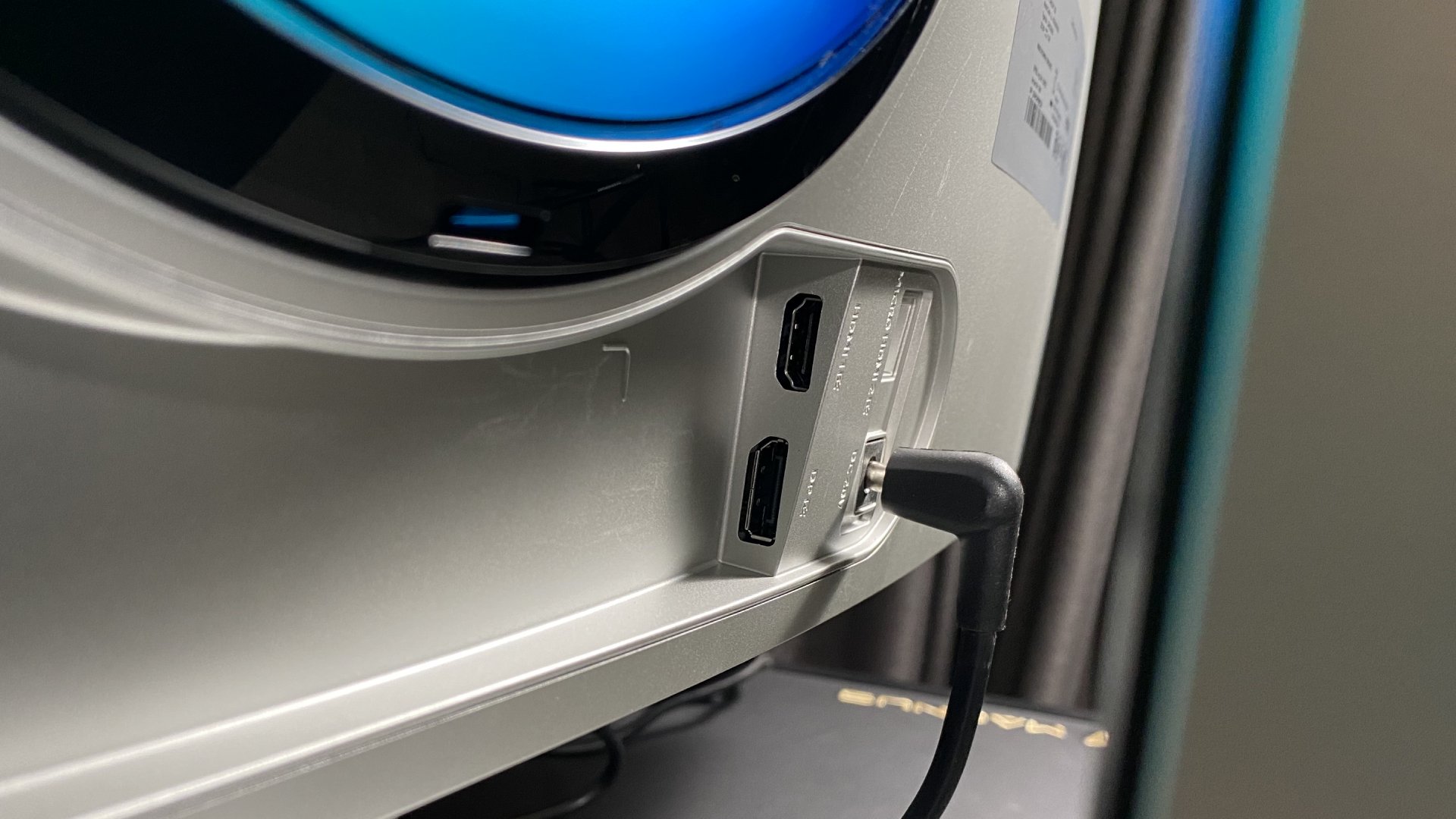
That's a real boon for non-gaming applications. Suffering the brightness bouncing around on the desktop when you open and close browser windows on those LG OLED monitors is pretty distracting. But there's none of that on this panel.
Of course, to that you can add perfect per-pixel lighting control and a lot more than 250 nits brightness in HDR highlights. In truth, the actual image quality on offer probably isn't any better than the QD-OLED Alienware and Philips panels we've reviewed previously. But the added scale of the 49-inch form factor subjectively ramps up the subjective drama.
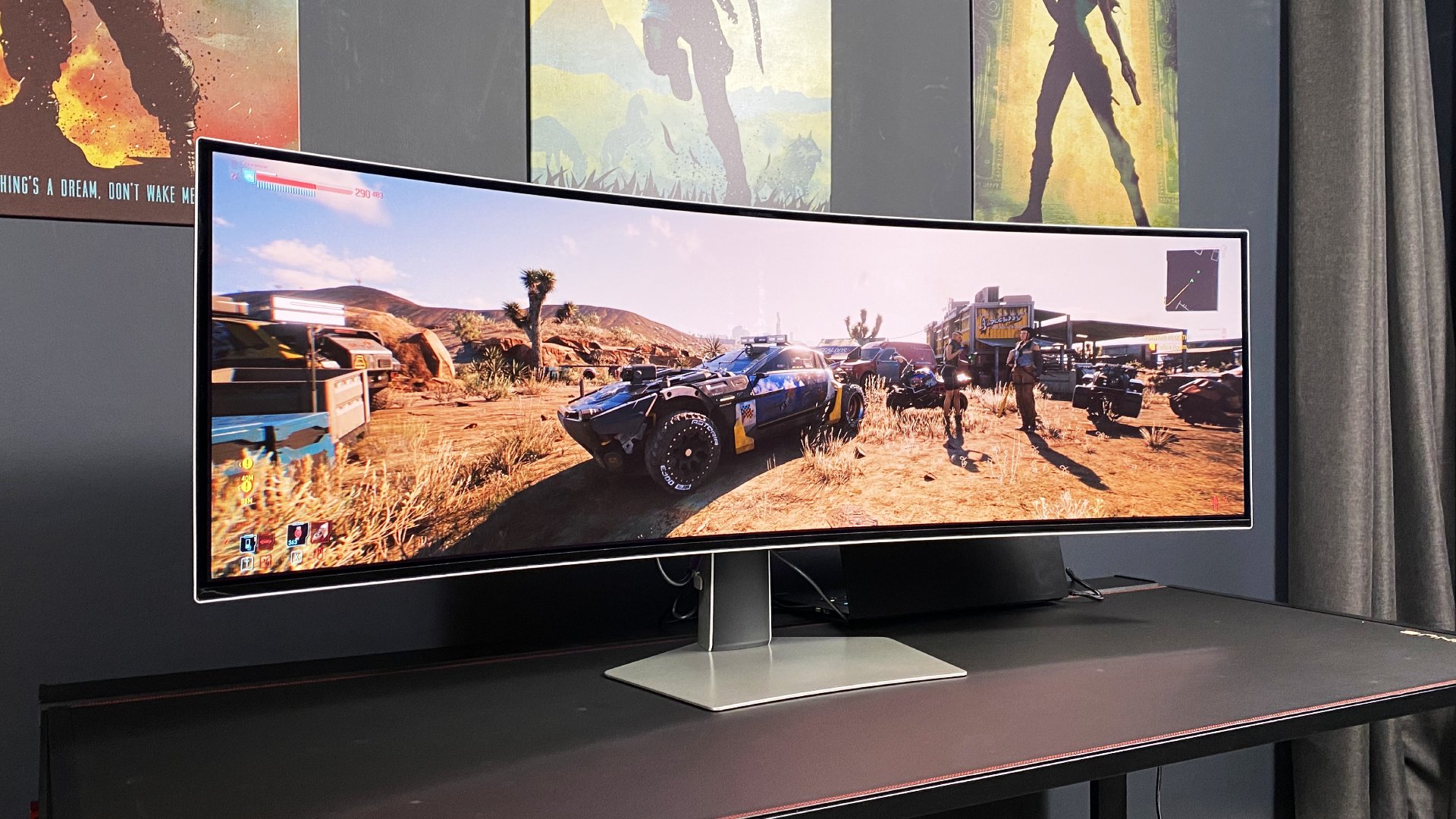
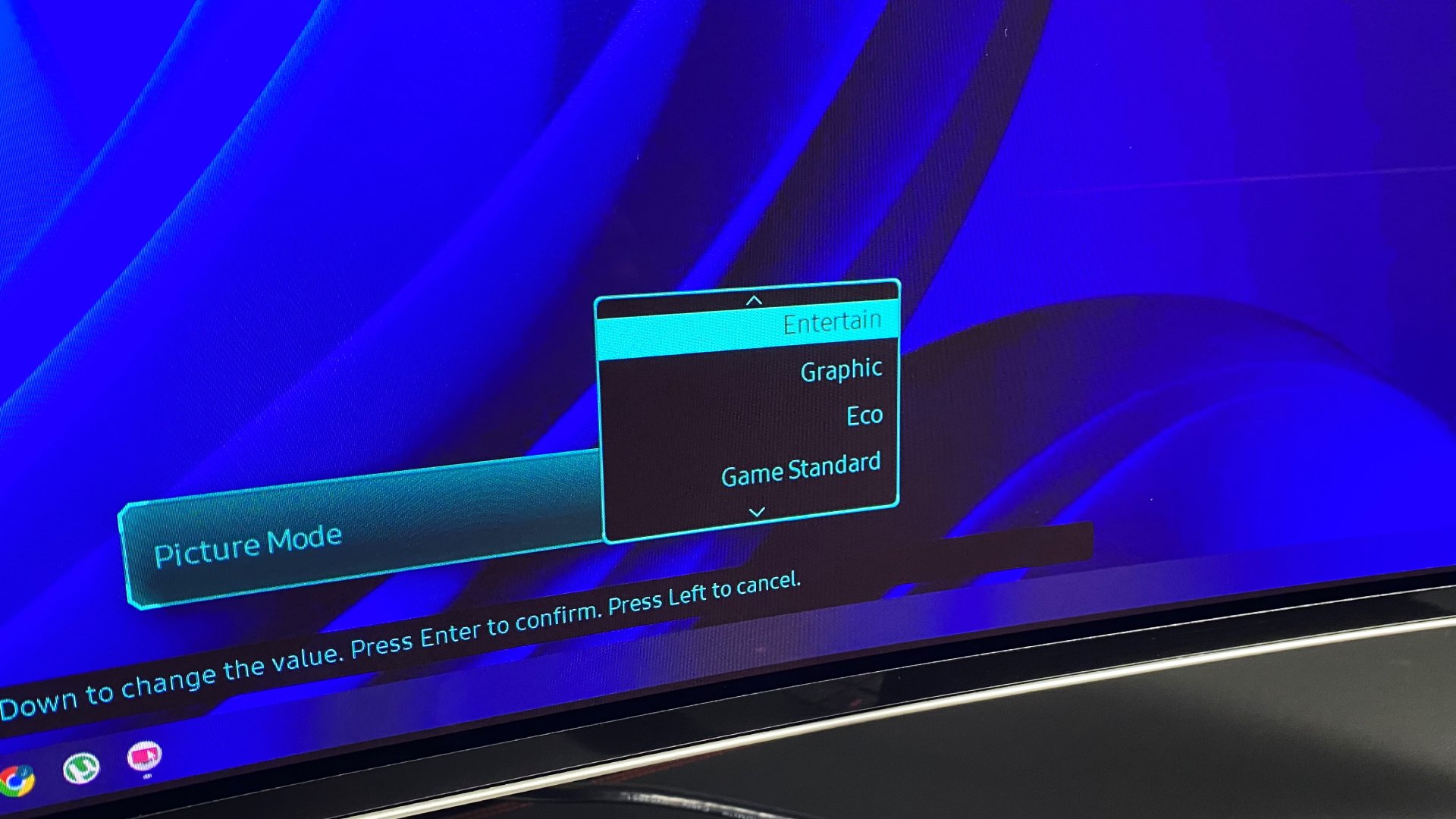
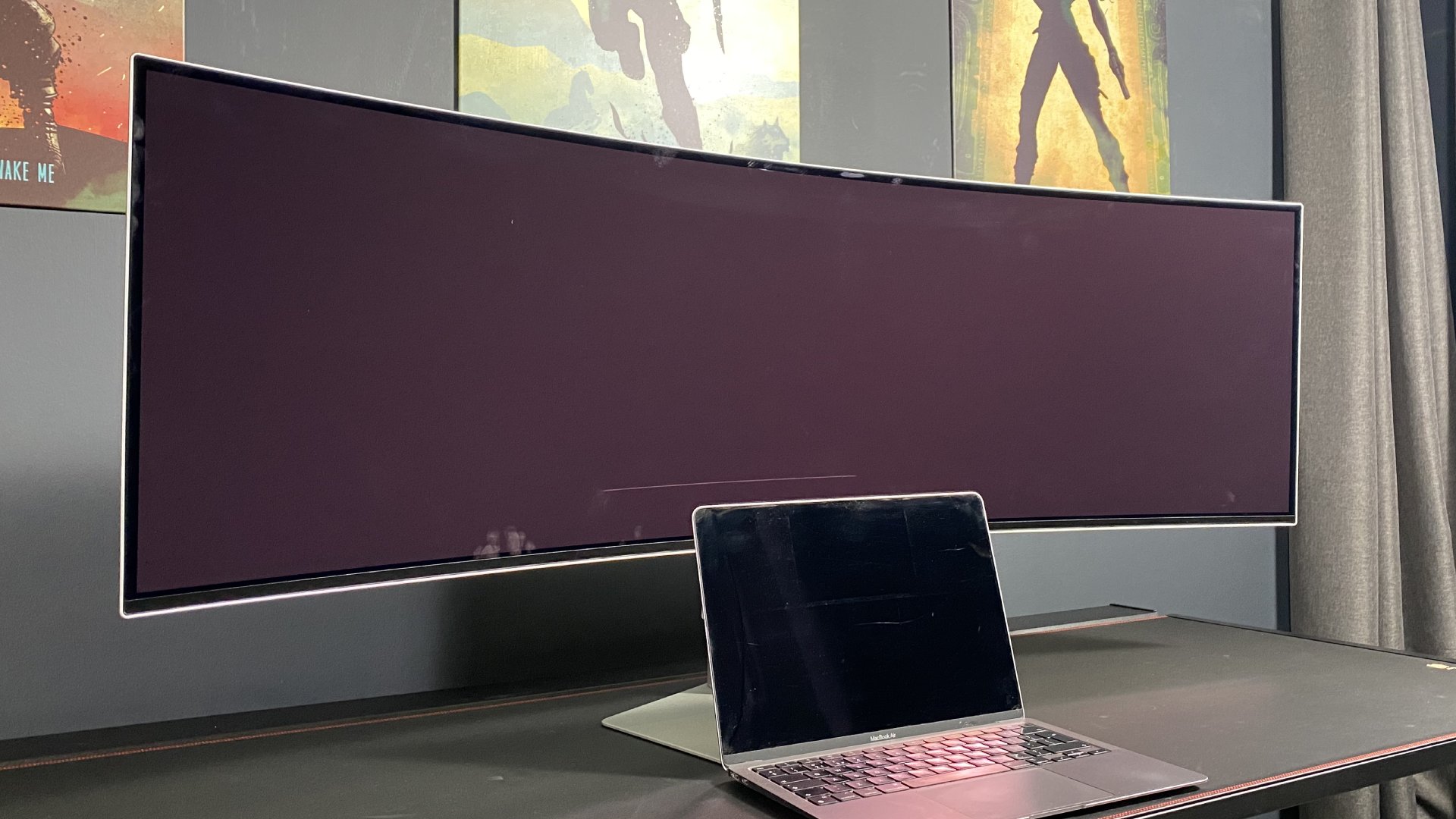


Put simply, this is the experience that the hype around HDR has long promised, but hitherto failed to deliver. A perfect example is the underground bar scene in Cyberpunk 2077 with its combination of moody, inky black tones and sizzling neon light bars. It looks absolutely stellar on the OLED G9.
Of course, with 240Hz refresh and 0.03ms response, this monitor is silly quick, too. So, yeah, this is a pretty exceptional gaming experience overall. If we do have doubts, well, they come down to the fundamental form factor and some of the known issues with the Samsung QD-OLED panel.
If you want nice crisp fonts, this isn't the monitor for you.
For starters, whether you'll like the 32:9 aspect is pretty personal. It's certainly immersive, but it doesn't play well with all games, that's for sure. Just as a for instance, there are relatively few games that actually give you a wider field of view with a 32:9 panel. Instead, the image is stretched at the sides. That's true of all online shooters and it's also true of most single player games, too.
The 1,440 pixel vertical resolution feels a little constraining at this lofty end of the monitor market, too. And the pixel density isn't great for non-gaming tasks, either. If you want nice crisp fonts, this isn't the monitor for you, a fact exacerbated by the non-standard subpixel layout of the QD-OLED panel.
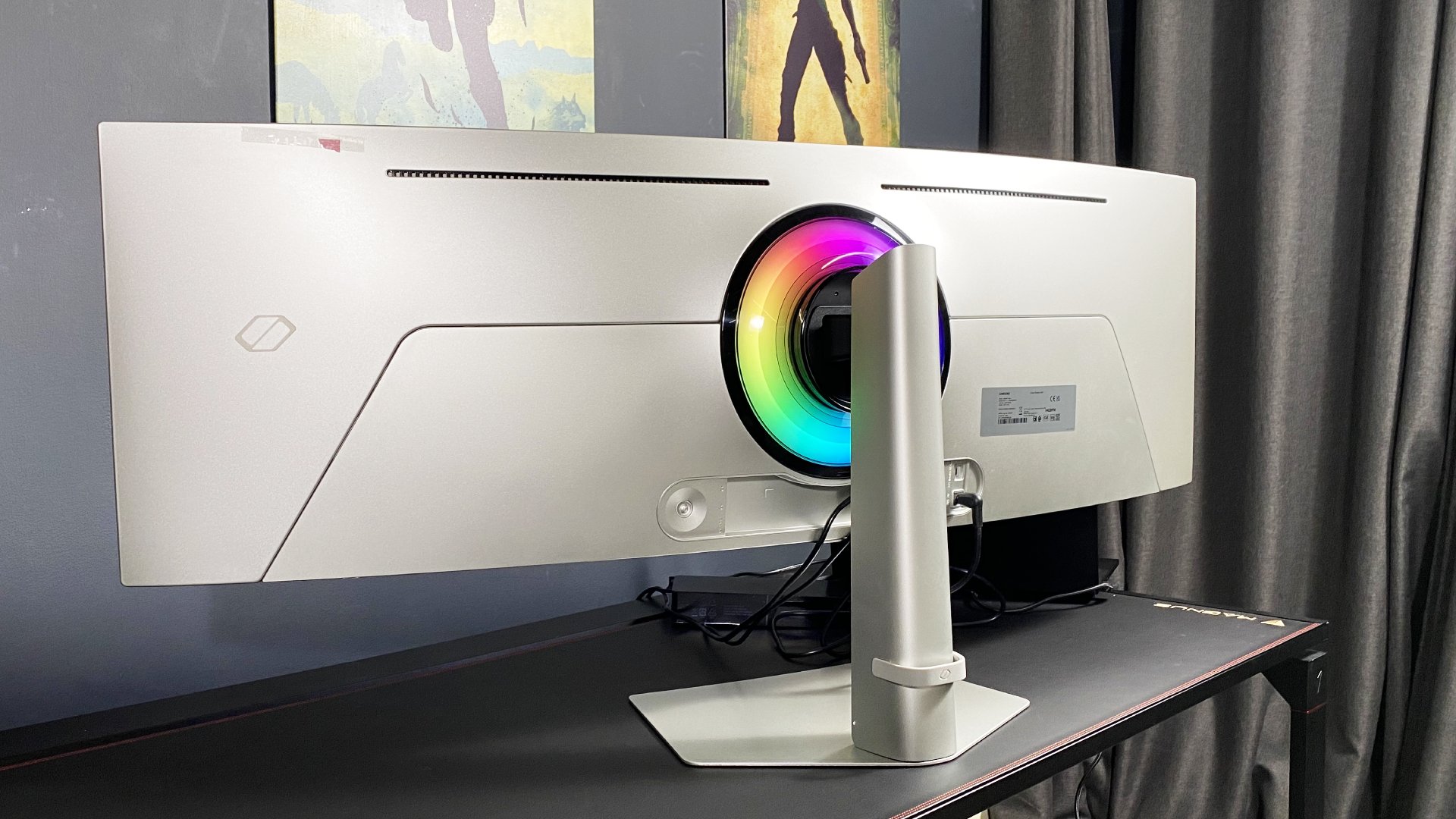
As for worries about burn-in and image retention, well, the jury remains out to some degree. Some third party testing has implied that Samsung's QD-OLED panel tech might be slightly more susceptible than LG's WOLED panels. Time will tell, but Samsung does have various mitigation measures, not least of which is significant pixel overprovision. If you look closely at the edges of the panel, you can see quite a few pixels around the edge outside of the actual viewable image, which allows Samsung to "shift" the image periodically.
✅ You want the ultimate OLED experience: A 34-inch ulrtrawide OLED monitor probably makes more sense. But you can't argue with the epic scale of this 49-inch monster. it's a gaming experience like no other.
❌ You want an excellent all-rounder: The 32:9 aspect ratio isn't ideal for every game. Moreover, the mediocre pixel density and non-standard subpixel structure doesn't make for terribly crisp fonts on the desktop.
All of which means that the Samsung Odyssey OLED G9 G93SC is both unsurprising and pretty fantastic. It's unsurprising because it doesn't deviate in performance and image quality terms from other QD-OLED monitors. It's just the added scale makes the end result even more spectacular.
So, you could very much make the case for this being the best gaming experience currently available from a PC monitor. It's utterly stunning. It's also not quite as expensive as we'd feared. Annoyingly, we don't actually have final pricing.
But it will surely be cheaper than its smart hub-equipped sibling, which goes for $2,199 in the US and £1,599 in the UK. That would make the UK price in particular pretty appealing given that the 34-inch OLED G8 is £1,299.
Speaking of which, the main problem with this huge 49-inch model is the existence of those 34-inch alternatives. The Alienware 34 AW3423DWF recently dipped to $899 on Amazon Prime day and, to be honest, we'd go for that over the OLED G9. But if you can afford it and you like the 32:9 aspect, well, we wouldn't blame you. This is a stupendous gaming screen.
Samsung has just raised the bar for gaming monitors. The new Samsung Odyssey OLED G9 G93SC takes its already outstanding QD-OLED panel tech and stretches it out to epic 49-inch, 32:9 aspect proportions. The results are suitably stupendous. But we'd probably still prefer the more mainstream 21:9 alternatives.

Jeremy has been writing about technology and PCs since the 90nm Netburst era (Google it!) and enjoys nothing more than a serious dissertation on the finer points of monitor input lag and overshoot followed by a forensic examination of advanced lithography. Or maybe he just likes machines that go “ping!” He also has a thing for tennis and cars.


